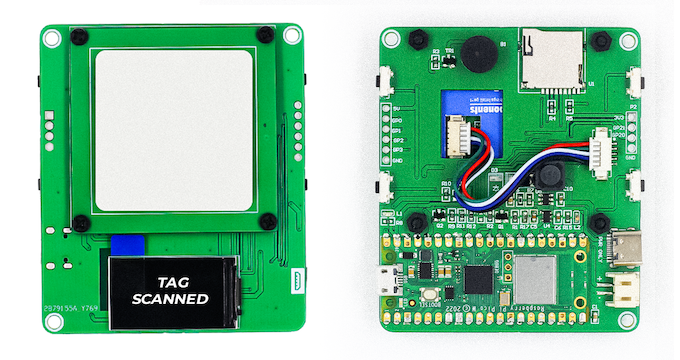RFID (Radio Frequency Identification) is a technology that allows data to be transferred between a reader and a tag through radio waves. The use of RFID has become increasingly popular in various industries, including retail, logistics, and healthcare, due to its ability to provide real-time information about the location and status of goods or assets. UHF (Ultra-High Frequency) RFID is one of the most common types of RFID used in industry today, and it can read multiple tags simultaneously, making it a popular choice for applications that require rapid and accurate tag reading.
The UHF RFID Reader is an essential tool for businesses that rely on RFID technology for inventory management, asset tracking, and other applications. The UHF Reader can read up to 50 tags per second within a range of 1.5 meters, making it a powerful tool for rapid multi-tag reading.
The UHF Reader comes in two versions, one based on the Raspberry Pi Pico W and another based on the ESP32. Both versions have onboard Wi-Fi and Bluetooth capabilities, making them versatile tools for a wide range of applications. Let's take a closer look at each version.
UHF Reader based on Raspberry Pi Pico W
The UHF Reader based on Raspberry Pi Pico W is a compact and powerful reader that has all the capabilities of the Raspberry Pi Pico W onboard. This means that the user does not need to use any microcontroller or single-board computer to run this UHF board. It also gives the user the ability to use Wi-Fi and Bluetooth capabilities, which can be used in a wide range of applications.
The UHF Reader can be programmed directly via the micro USB port, and it has a 1.3" LCD onboard that displays all the necessary information required. The user does not need any external antenna as it has an inbuilt antenna that gives an amazing range of 1.5 meters. The battery connector is also very helpful in many situations.
You Might Also Like:
- IdentiPi: A Compact Fingerprint HAT for Raspberry Pi Pico
- Connect your embedded devices effortlessly with ESPi - the Ethernet Board based on ESP32
- PiCoder - Pico Learning Kit with Free Live Training 100% DIY Learning kit
UHF Reader based on ESP32
The UHF Reader based on ESP32 is another powerful and versatile reader that has all the possibilities for Wi-Fi and Bluetooth compatibilities that can be used in a wide range of applications. It has an onboard SD card slot, battery connector, and onboard 1.14" LCD. This board can also read up to 50 tags per second and can be used 24 x 7.
Both versions of the UHF Reader have a standby current of <80mA (EN pin high level) and a sleeping current of <100uA (EN pin low level). The frequency is 840-960MHZ, and the tags storage capacity is 200pcs tags @ 96-bit EPC. The receive sensitivity is < -70dBm, and the communication interface is the TTL Uart interface. The communication baud rate is 115200 bps (default and recommend) and 38400 bps. The UHF Reader can work normally for 24 hours x 365 days.
UHF Reader is an essential tool for businesses that rely on RFID technology for inventory management, asset tracking, and other applications. With its ability to read multiple tags simultaneously and a range of up to 1.5 meters, the UHF Reader is a powerful tool for rapid multi-tag reading. The two versions of the UHF Reader based on Raspberry Pi Pico W and ESP32 are versatile tools that can be used in a wide range of applications due to their onboard Wi-Fi and Bluetooth capabilities.
It's worth noting that a new UHF Reader has just launched on Kickstarter, promising even more features and capabilities. The new UHF Reader boasts a range of up to 3 meters and can read up to 100 tags per second, making it even more powerful than previous versions. It also features a sleek and compact design, making it easy to carry and use in a variety of settings.
The Kickstarter campaign offers early-bird discounts for those who pledge early, making it an attractive option for businesses looking to upgrade their RFID capabilities. It will be exciting to see how the new UHF Reader performs and the impact it will have on the industry.






















0 Comments